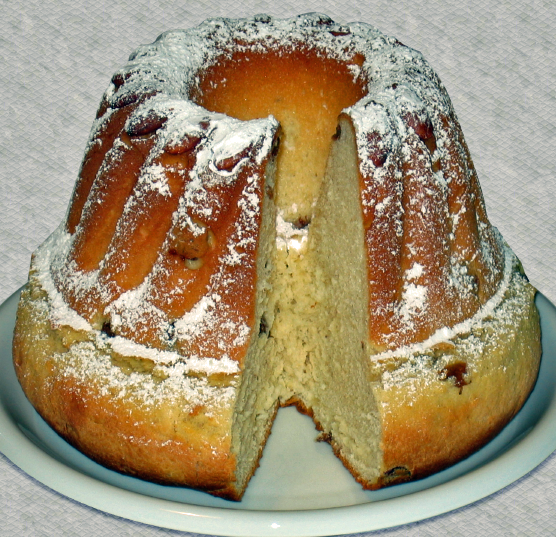
One wonders if you have a genuine “Kaisergugelhupf” (Emperor bundt cake) on your plate at the Café. Only bakers and baking enthusiasts, who do a little research would be familiar with the true consistency of the dough.

We all know, there are many different variations on the internet, and there is very large collections of fake recipes among them. The difference is very simple, and can be clarified with a little research
I’ve already done the research for you, you can see the recipe when you scroll down
The historical background for the true recipe of the “Kaisergugelhupf” (Bundt cake of Emperor Kaiser Joseph I) has been handed down. Some baker’s have dared to call their cakes “Kaisergugelhupf” because their cake did not comply with the original

The Kaiser (emperor), whose title helped to honor the Kaisergugelhupf, was of course Franz Joseph I of Austria (1830-1916). German and Austrian people who are born after 1955 know him best as the husband of Sissi (Empress Elisabeth).
It has been known, that Kaiserin Elisabeth never felt particularly comfortable at the castle in Vienna. She took every opportunity to escape the court etiquette, and therefore traveled a lot. Initially she left for health reasons to a warmer climate, and later to avoid her duties

In order to alleviate the Kaiser’s loneliness, and to lessen the expectations placed on her, the empress arranged that her husband get to know the actress and cabaret artist Katharina Schratt in 1885. From then on Ms. Schratt became the contact person and confidant of the emperor.
Mistress Katharina Schratt and her original Gugelhupf
Kaiser Franz Joseph’s friendship with Katharina Schratt was saved from any scandal and expressly encouraged by the Kaisers wife. Even after Kaiserin Elisabeth’s death, their relationship has been maintained.


Kaiser Franz Josef supported the actress financially and gifted her jewelry. Among other things, he provided her with a villa in Bad Ischl, where the Austrian imperial family resided in the summer. Today called “Schratt Villa” or “Villa Schratt”
Kaiser Franz Joseph is said to awaken early in the morning around 6.30 every day. He had his second breakfast at the “Schratt Villa” which was close to the Schönbrunn castle. Katharina Schratt would bake and serve her Gugelhupf every day according to a recipe from her mother.
Kaisergugelhupf

Gugelhupfrezept aus Anna Fink: Die Küche des Mittelstandes. Neues Wiener Kochbuch für jeden Haushalt. Wien: Moritz Stern 1907, S. 507 (per Wikimedia)
If her own baking skills should fail, she also ordered an extra for the daily cake as a back-up from the traditional confectionery bakery Zauner. This is why the “Double” was soon called Kaisergugelhupf or Schratt-Gugelhupf.

Katharina Schratt’s recipe has been preserved to this day. We don’t know if it is true that Zauner’s Bakery made six of these cakes at a time, and only the most beautiful was delivered to the Schratt Villa. This story, or better said gossip, sounded interesting and amusing and was told at many Kaffeklatsch’s with the ladies

The Kaiser Guglhupf is very rich! By adding lots of butter and six egg yolks, the dough is not exactly something for calorie or cholesterol aware people.
The original Gugelhupf
Ingredients
- 1 cup whole cream
- 1 pack dry yeast
- 4 cups white flour
- 2/3rd cup soft butter
- 1 cup white sugar
- 6 egg yolks
- 1 dash salt
- Zest of one lemon (organic)
- Filling:
- 1 tbsp cinnamon
- 1/3rd cup raisins (soaked in rum, optional)
- Baking form preparation:
- Some butter
- ½ cup chopped almonds
- When cooled, some powdered sugar
Instructions
- Warm up the whole cream to lukewarm and dissolve the dry yeast in it. Add a teaspoon of sugar and a little flour. Let rest 10 minutes. Sieve the remaining flour over the batter, keep warm and let rise for at least 20 minutes.
- In a separate small bowl stir the very soft but not liquid butter with the remaining sugar until foamy and all the sugar is dissolved. Add and mix with the six yolks.
- Add a little salt and zest from a lemon to the yeast batter, combine a butter/yolk mixture. Beat the batter in a mixer with a dough hook to a soft, silky dough until it separates from the bowl rim.
- Cover and let rest for at least 60 minutes (or longer).
- Due to its high butter content, the dough will of course not rise as easily and easy as usually with other yeast doughs. Nevertheless, the volume of the dough should have increased by at least a third or half of the original amount.
- When the dough has risen, roll out to a rectangle on a floured work surface about half a centimeter thick. Sprinkle evenly with cinnamon and raisins and roll up.
- Preheat the oven to 350 F top / bottom heat.
- Prepare a Gugelhupf or Bundt cake pan with soft butter and sprinkle with sliced almonds. Place the rolled-up dough inside and brush with more butter. Let rise again at a warm place up to just below the rim.
- Then bake at 350 F for about 40-50 minutes. If the “Kaisergugelhupf” gets too dark, cover it with aluminum foil in the last few minutes if necessary. Definitely make a stick test!
- Let the finished Gugelhupf fall out of the mold, let cool then sprinkle with powdered sugar.
Notes
Remove from baking form, let cool on wire rack and cover with powdered sugar. Store in plastic foil for 3 days or freeze.


